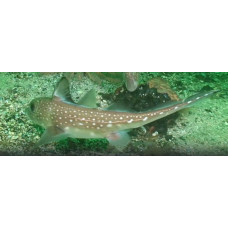Latin name
Hydrolagus colliei
Other names
Hydrolagus colliei
Identification
The skeleton is cartilaginous. They have a short and sharply rounded snout. There is a gill opening on each side of the body. The mouth is lower. Males have pterygopodia. Eyes are oval, green in life. On both sides of the head there are gill openings covered by a fold of skin. The skin is bare. Males have a protrusion with a thickened end above the eyes.
Features of fish fins
2 dorsal fins. The first fin is triangular, vertical, with a short base. The edges of the spine at the base of the fin are smooth. Second dorsal fin is low, long, with a notch in the middle. Anal fin is absent. Pectoral fins in folded position do not reach the base of the pelvic fins. The caudal fin is lanceolate and pointed at the tip.
Fish colouring
The body coloration is silvery with golden pale markings. The flanks are covered with small white patches. The belly is white.
Distribution
Occurs from southern California to the southeastern Gulf of Alaska. It is the most common chimaera in British Columbia waters.
Habitat
This marine demersal fish is found at depths from 0 to 913 m, most commonly in the 50-400 m range. It prefers temperate climates, muddy and sandy bottoms.
Size
Newborns are about 14 cm long. Adults reach 1 m in length and a maximum recorded mass of 2.5 kg.
Behavior
Found in abundance in cold waters at moderate depths.
Food and feeding habits
The diet consists mainly of crustaceans, mollusks and fish.
Reproduction
Sex and size segregation is observed. They reproduce by laying eggs enclosed in a brown horny capsule about 12 cm long. Eggs are found on muddy bottoms in October-November. Breeding occurs throughout the year. The peak is from late spring to fall. Females lay two eggs at a time. A clutch can last 30 hours until the female has laid all the eggs. Before laying, the female carries the eggs attached to the oviducts for 4-6 days. Eggs are placed vertically on the ground and are secured by projections. Female fecundity is estimated at 20-29 eggs per year. Incubation period is 12 months. Males and females reach sexual maturity at 15-16 cm and 19 cm, respectively.
Fishing
Fishing value is insignificant. It is caught as bycatch in bottom trawls when fishing for other fish.
Relationship with a person
The spine can be dangerous and cause painful wounds. The flesh is edible but has an unpleasant taste. Liver fat is used to make machine oil.
| Classification | |
| Phylum | Chordata |
| Class | Chondrichthyes |
| Squad | Chimaeriformes |
| Family | Chimaeridae |
| Genus | Hydrolagus |
| Species | H. colliei |
| Features | |
| Conservation status | Least Concern |
| Habitat | Pelagic |
| Life span, years | No information |
| Maximum body weight, kg | 2,5 |
| Maximum length, cm | 100 |
| Sailing speed, m/s | No information |
| Threat to people | Not edible |
| Way of eating | Predator |
Spotted ratfish
Tags: spotted ratfish


